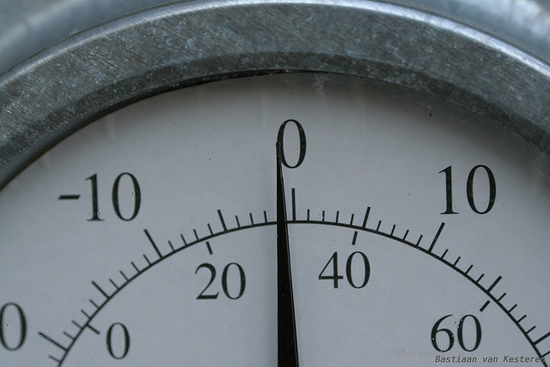Ready for the Big Chill?
Subzero cold calls for safety measures

Bundle up and stay safe: this week’s Arctic cold snap means taking precautions against frostbite and hypothermia. Photo courtesy of Flickr contributor Bastiaan van Kesteren
What’s been a mostly mild winter so far is finally baring its teeth this week, with ferocious winds and plunging temperatures. The National Weather Service is forecasting that an intense Arctic cold front will arrive today, bringing bitter cold temperatures and wind gusts of 25 to 35 miles per hour. “As the temperature continues to plummet, wind chills are expected to reach 15 to 30 degrees below zero in some areas,” says Steve Morash, director of BU Emergency Response Planning.
“This cold outbreak will be different,” warns Alyson Hoegg, a meteorologist for AccuWeather.com. “Unlike previous cold outbreaks, this round of cold weather will be long lasting, likely spanning the entire week.” Despite some sunshine, Thursday will probably be the coldest day this week, with temperatures in the Boston area expected to be in the single digits or lower. Strong winds will make it feel even colder.
BU staff and students, especially those unaccustomed to cold climates, should review precautions listed on the City of Boston safety web page. Most important is dressing for the severe cold: wear several layers of loose-fitting, lightweight, warm clothing rather than one layer of heavy clothing. Be sure that your outer layer is tightly woven and windproof. Cover all exposed skin and watch for frostbite. In extreme cold, frostbite can happen in less than a minute, and wind only makes the risk greater.
The symptoms of frostbite (freezing of the skin and underlying tissues) include loss of feeling and white or pale appearance in extremities such as fingers, toes, ear lobes, and the tip of the nose. Anyone with these symptoms should visit Student Health Services. Signs of hypothermia (a dangerously low body temperature) include uncontrollable shivering, memory loss, disorientation, incoherence, slurred speech, drowsiness, and apparent exhaustion. If you or someone you know shows any of these symptoms, call 911 immediately.
Severe cold can take a toll on buildings as well as people, says Thomas Daley, BU associate vice president in Facilities Management & Planning. “Our buildings all have heating/cooling, fire sprinkler, and lab cooling systems that can easily freeze up when subjected to subfreezing temperatures,” he says. “We have had doors that do not close all the way because of snow and ice, windows in offices that are left open, and dorm room windows that are opened to let in a breath of fresh air and never closed.” Close the windows and keep them closed, he says.
“When you add high winds to the mix, disaster can result,” says Daley. Wind can drive the cold air several feet into a space, quickly freezing water lines, which can rupture, resulting in flooding. This whole scenario can be prevented by ensuring that all of your spaces are completely buttoned up when you leave the room or building, says Daley, adding that “If you see open windows and doors in extreme temperatures report them to the FMP emergency line at 353-2105. Close up your coats, windows and doors, and keep yourselves and your spaces warm.”
Other tips for cold weather safety include:
- Be aware of extreme weather conditions by continuously monitoring media reports.
- In addition to dressing in layers with a tightly woven and water repellent outer garment, wear a hat (most body heat is lost through the top of the head), mittens (better than gloves), and sturdy waterproof boots, protecting your extremities. Cover your mouth with a scarf to protect your lungs.
- Make sure you always have a well-stocked winter home emergency kit that includes flashlights, a portable radio, extra batteries, a first aid kit, bottled water, non-perishable food, and a manual can opener. Do not use candles.
- When using alternate heating sources, such as a fireplace, wood stove, or space heater, take the necessary safety precautions. Keep a fire extinguisher handy and ensure everyone knows how to use it properly. Test smoke alarms and carbon monoxide (CO) detectors to make sure they are in working order.
- If you lose your heat, seal off unused rooms by stuffing towels in the cracks under the doors. At night, cover windows with extra blankets or sheets.
- Be a good neighbor. Check with elderly relatives and friends who may need assistance to ensure their safety.
- To keep pipes from freezing, wrap them in insulation or layers of newspapers, covering the newspapers with plastic to keep out moisture. Allow a trickle of warm water to run from a faucet that is farthest from your water meter or one that has frozen in the past. This will keep the water moving so that it cannot freeze. Be sure you know how to shut off your water supply, should a pipe burst.
- Drink non-caffeinated fluids. Dehydration occurs more quickly in cold, dry weather. Be sure to keep yourself well hydrated, especially if you are exerting yourself.
- Don’t drink alcohol. Alcohol can speed the onset and worsen the effects of hypothermia.
- Make sure your car is properly winterized. Keep the gas tank at least half-full. Carry emergency blankets, extra clothing, a flashlight with spare batteries, nonperishable foods, a windshield scraper, shovel, sand, towrope, and jumper cables.
- Ensure you have sufficient heating fuel.
Additional information about winter preparedness can be found here.
Comments & Discussion
Boston University moderates comments to facilitate an informed, substantive, civil conversation. Abusive, profane, self-promotional, misleading, incoherent or off-topic comments will be rejected. Moderators are staffed during regular business hours (EST) and can only accept comments written in English. Statistics or facts must include a citation or a link to the citation.